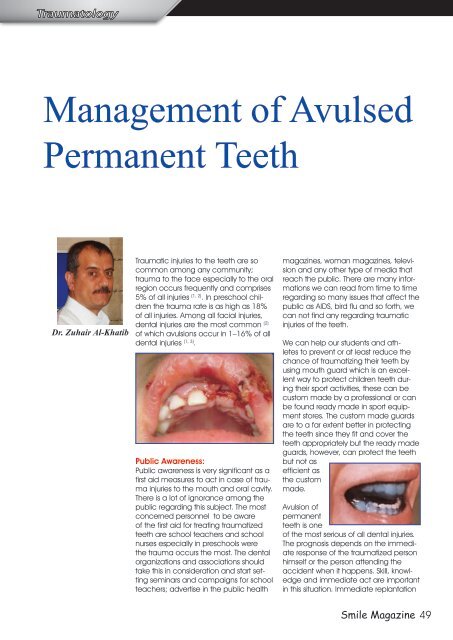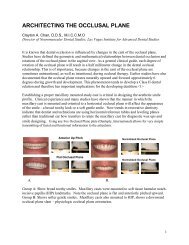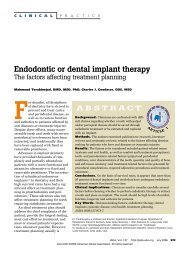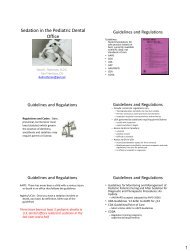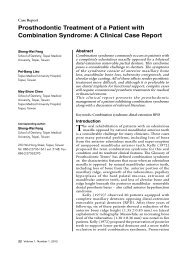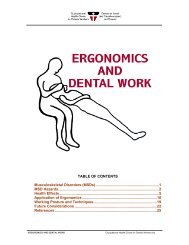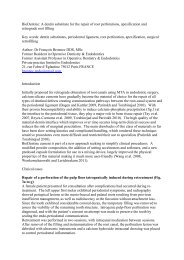Management_of_Avulsed_Permanent_Teeth
Management_of_Avulsed_Permanent_Teeth
Management_of_Avulsed_Permanent_Teeth
Create successful ePaper yourself
Turn your PDF publications into a flip-book with our unique Google optimized e-Paper software.
Traumatology<br />
<strong>Management</strong> <strong>of</strong> <strong>Avulsed</strong><br />
<strong>Permanent</strong> <strong>Teeth</strong><br />
Dr. Zuhair Al-Khatib<br />
Traumatic injuries to the teeth are so<br />
common among any community;<br />
trauma to the face especially to the oral<br />
region occurs frequently and comprises<br />
5% <strong>of</strong> all injuries (1, 2) . In preschool children<br />
the trauma rate is as high as 18%<br />
<strong>of</strong> all injuries. Among all facial injuries,<br />
dental injuries are the most common (2)<br />
<strong>of</strong> which avulsions occur in 1–16% <strong>of</strong> all<br />
dental injuries (1, 3) .<br />
Public Awareness:<br />
Public awareness is very significant as a<br />
first aid measures to act in case <strong>of</strong> trauma<br />
injuries to the mouth and oral cavity.<br />
There is a lot <strong>of</strong> ignorance among the<br />
public regarding this subject. The most<br />
concerned personnel to be aware<br />
<strong>of</strong> the first aid for treating traumatized<br />
teeth are school teachers and school<br />
nurses especially in preschools were<br />
the trauma occurs the most. The dental<br />
organizations and associations should<br />
take this in consideration and start setting<br />
seminars and campaigns for school<br />
teachers; advertise in the public health<br />
magazines, woman magazines, television<br />
and any other type <strong>of</strong> media that<br />
reach the public. There are many informations<br />
we can read from time to time<br />
regarding so many issues that affect the<br />
public as AIDS, bird flu and so forth, we<br />
can not find any regarding traumatic<br />
injuries <strong>of</strong> the teeth.<br />
We can help our students and athletes<br />
to prevent or at least reduce the<br />
chance <strong>of</strong> traumatizing their teeth by<br />
using mouth guard which is an excellent<br />
way to protect children teeth during<br />
their sport activities, these can be<br />
custom made by a pr<strong>of</strong>essional or can<br />
be found ready made in sport equipment<br />
stores. The custom made guards<br />
are to a far extent better in protecting<br />
the teeth since they fit and cover the<br />
teeth appropriately but the ready made<br />
guards, however, can protect the teeth<br />
but not as<br />
efficient as<br />
the custom<br />
made.<br />
Avulsion <strong>of</strong><br />
permanent<br />
teeth is one<br />
<strong>of</strong> the most serious <strong>of</strong> all dental injuries.<br />
The prognosis depends on the immediate<br />
response <strong>of</strong> the traumatized person<br />
himself or the person attending the<br />
accident when it happens. Skill, knowledge<br />
and immediate act are important<br />
in this situation. Immediate replantation<br />
Smile Magazine 49
50<br />
Traumatology<br />
Smile Magazine<br />
<strong>of</strong> the permanent teeth is the treatment <strong>of</strong><br />
choice, if it can be performed at the time<br />
and place <strong>of</strong> the accident.<br />
Furthermore, replantation should not be<br />
performed when primary teeth have been<br />
avulsed because <strong>of</strong> the risk <strong>of</strong> injury to the<br />
underlying permanent tooth germ. Treatment<br />
plan after trauma is important for a<br />
good prognosis.<br />
Dentists should always be prepared to<br />
give appropriate advice to the public<br />
about first aid for avulsed teeth. If a tooth<br />
is avulsed, make sure it is a permanent<br />
tooth:<br />
• Talk to the patient and keep him calm.<br />
• Find the tooth and pick it up by the<br />
crown and avoid touching the root.<br />
• If the tooth is dirty, wash it for about<br />
10 seconds under cold running water<br />
and reposition it. Try to encourage the<br />
patient/parent to replant the tooth. Bite<br />
on a clean piece <strong>of</strong> cloth to hold it in<br />
position.<br />
• If this is not possible, place the tooth in<br />
a suitable storage medium, e.g. a glass<br />
<strong>of</strong> milk or in saline. The tooth can also be<br />
transported in the mouth, keeping it between<br />
the molars and the inside <strong>of</strong> the<br />
cheek. These are transport media that<br />
can be used and named according to<br />
its viability respectively (milk, saline and<br />
saliva). Avoid dry storage or in water.<br />
• Seek emergency dental treatment immediately.<br />
Recommendations for the dentist:<br />
1. Medical examination for bleeding,<br />
wounds, vomiting or disorientation <strong>of</strong><br />
the patient.<br />
2. Proper dental examination.<br />
3. Radiographic examination. As a routine,<br />
several angles are recommended:<br />
a. 90° horizontal angle, with central<br />
beam through the traumatized tooth.<br />
b. occlusal view.<br />
c. lateral view from the mesial or distal<br />
aspect <strong>of</strong> the traumatized tooth.<br />
4. Sensibility tests, electric pulp test or cold<br />
test, to determine the condition <strong>of</strong> the<br />
tooth pulp. Initial tests following an injury<br />
frequently give negative results, but<br />
such results may only indicate a transient<br />
lack <strong>of</strong> pulpal response. Follow-up<br />
controls are needed to make a definitive<br />
pulpal diagnosis.<br />
5. Patient instructions. Good healing following<br />
an injury to the teeth and oral tissues<br />
depends on good oral hygiene. Patients<br />
should be advised on how to care for<br />
teeth that have received treatment<br />
after an injury. Brushing with a s<strong>of</strong>t brush<br />
and rinsing with chlorhexidine 0.1% is<br />
beneficial to prevent accumulation <strong>of</strong><br />
plaque and debris.<br />
Treatment guidelines as published in some<br />
articles (see references) by leaders in traumatic<br />
dental injuries can be followed, and<br />
I advise my colleague dentists to be a<br />
member <strong>of</strong> the International Association <strong>of</strong><br />
Dental Traumatology (IADT), to keep them<br />
up-to-date with the latest in this field.
Treatment <strong>of</strong> avulsed permanent teeth with closed apex:<br />
Clinical situation<br />
(1) The tooth has been replanted<br />
prior to the patient<br />
arriving at the dental clinic.<br />
(2) The tooth has been kept<br />
in special storage media<br />
(Hank’s Balanced Salt Solution),<br />
milk, saline or saliva.<br />
The extra-oral dry time is less<br />
than 60 min.<br />
Treatment<br />
Clean the area with water spray, saline, or chlorhexidine. Do not extract<br />
the tooth. Suture gingival lacerations if present. Verify normal position <strong>of</strong> the<br />
replanted tooth both clinically and radiographically. Apply a flexible splint for<br />
up to 2 weeks.<br />
Administer systemic antibiotics. Tetracycline is the first choice (Doxycycline<br />
2x per day for 7 days at appropriate dose for patient age and weight). The<br />
risk <strong>of</strong> discoloration <strong>of</strong> permanent teeth must be considered before systemic<br />
administration <strong>of</strong> tetracycline in young patients. (In many countries tetracycline<br />
is not recommended for patients under 12 years <strong>of</strong> age). In young<br />
patients Phenoxymethyl Penicillin (Pen V), in an appropriate dose for age<br />
and weight, can be given as alternative to tetracycline.<br />
If the avulsed tooth has contacted soil, and if tetanus coverage is uncertain,<br />
refer to physician for evaluation and need for a tetanus booster.<br />
Initiate root canal treatment 7–10 days after replantation and before splint<br />
removal. Place calcium hydroxide as an intra-canal medicament until filling<br />
<strong>of</strong> the root canal.<br />
Patient instructions:<br />
S<strong>of</strong>t diet for up to 2 weeks.<br />
Brush teeth with a s<strong>of</strong>t toothbrush after each meal.<br />
Use a chlorhexidine (0.1%) mouth rinse twice a day for 1 week.<br />
Follow-up.<br />
stream <strong>of</strong> saline and place the tooth in saline. Remove the coagulum from<br />
the socket with a stream <strong>of</strong> saline. Examine the alveolar socket. If there is a<br />
fracture <strong>of</strong> the socket wall, reposition it with a suitable instrument. Replant<br />
the tooth slowly with slight digital pressure. Suture gingival lacerations. Verify<br />
normal position <strong>of</strong> the replanted tooth both clinically and radiographically.<br />
Apply a flexible splint for up to 2 weeks.<br />
Administer systemic antibiotics. Tetracycline is the first choice (Doxycycline<br />
2x per day for 7 days at appropriate dose for patient age and weight). The<br />
risk <strong>of</strong> discoloration <strong>of</strong> permanent teeth must be considered before systemic<br />
administration <strong>of</strong> tetracycline in young patients. (In many countries tetracycline<br />
is not recommended for patients under 12 years <strong>of</strong> age). In young<br />
patients Phenoxymethyl Penicillin (Pen V), at appropriate dose for age and<br />
weight, can be given as alternative to tetracycline.<br />
If the avulsed tooth has contacted soil, and if tetanus coverage is uncertain,<br />
refer the patient to a physician for evaluation and need for a tetanus<br />
booster.<br />
Initiate root canal treatment 7–10 days after replantation and before splint<br />
removal. Place calcium hydroxide as an intra-canal medicament until filling<br />
<strong>of</strong> the root canal.<br />
Patient instructions:<br />
S<strong>of</strong>t diet for up to 2 weeks.<br />
Brush teeth with a s<strong>of</strong>t toothbrush after each meal.<br />
Use a chlorhexidine (0.1%) mouth rinse twice a day for 1 week.<br />
Follow-up.<br />
Smile Magazine 51
52<br />
Traumatology<br />
Clinical situation<br />
(3) Extra-oral dry time longer<br />
than 60 min.<br />
Treatment <strong>of</strong> avulsed permanent teeth with open apex:<br />
Clinical situation<br />
(1) The tooth has already<br />
been replanted prior to the<br />
patient<br />
arriving in the dental clinic.<br />
Smile Magazine<br />
Treatment<br />
Delayed replantation has a poor long-term prognosis. The periodontal ligament<br />
will be necrotic and not expected to heal. The goal in doing delayed<br />
replantation is to promote alveolar bone growth to encapsulate the replanted<br />
tooth. The expected eventual outcome is ankylosis and resorption <strong>of</strong> the<br />
root. In children below<br />
the age <strong>of</strong> 15, if ankylosis occurs, and when the infraposition <strong>of</strong> the tooth<br />
crown is more than 1 mm, it is recommended to perform decoronation to<br />
preserve the contour <strong>of</strong> the alveolar ridge.<br />
The technique for delayed replantation is:<br />
Remove attached necrotic s<strong>of</strong>t tissue with gauze.<br />
Root canal therapy can be done on the tooth prior to replantation, or it can<br />
be done 7–10 days later as for other replantations.<br />
Remove the coagulum from the socket with a stream <strong>of</strong> saline. Examine the<br />
alveolar socket. If there is a fracture <strong>of</strong> the socket wall, reposition it with a suitable<br />
instrument.<br />
Immerse the tooth in a 2% sodium fluoride solution for 20 min<br />
Replant the tooth slowly with slight digital pressure. Suture gingival laceration.<br />
Verify normal position <strong>of</strong> the replanted tooth clinically and radiographically.<br />
Stabilize the tooth for 4 weeks using a flexible splint.<br />
Administration <strong>of</strong> systemic antibiotics.<br />
Refer to physician for evaluation <strong>of</strong> need for a tetanus booster if the avulsed<br />
tooth has contacted soil or tetanus coverage is uncertain.<br />
Patient instructions:<br />
S<strong>of</strong>t diet for up to 2 weeks.<br />
Brush teeth with a s<strong>of</strong>t toothbrush after each meal.<br />
Use a chlorhexidine (0.1%) mouth rinse twice a day for 1 week.<br />
Follow-up.<br />
Treatment<br />
Clean the area with water spray, saline or chlorhexidine. Do not extract the<br />
tooth. Suture gingival lacerations if present. Verify normal position <strong>of</strong> the<br />
replanted tooth both clinically and radiographically. Apply a flexible splint for<br />
up to 2 weeks.<br />
Administer systemic antibiotics. For children 12 years and younger: Penicillin<br />
V at an appropriate dose for patient age and weight.<br />
Refer the patient to a physician for evaluation <strong>of</strong> need for a tetanus booster<br />
if avulsed tooth has contacted soil or tetanus coverage is uncertain.<br />
The goal for replanting still-developing (immature) teeth in children is to allow<br />
for possible revascularization <strong>of</strong> the tooth pulp. If that does not occur, root<br />
canal treatment may be recommended.<br />
Patient instructions:<br />
S<strong>of</strong>t diet for up to 2 weeks.<br />
Brush teeth with a s<strong>of</strong>t toothbrush after each meal.<br />
Use a chlorhexidine (0.1%) mouth rinse twice a day for 1 week.<br />
Follow-up.
Clinical situation<br />
(2) The tooth has been kept<br />
in special storage media<br />
(Hank’s Balanced Salt Solution),<br />
milk, saline, or saliva.<br />
The extraoral dry time is less<br />
than 60 min.<br />
(3) Extra-oral dry time longer<br />
than 60 min.<br />
Treatment<br />
If contaminated, clean the root surface and apical foramen with a stream<br />
<strong>of</strong> saline. Remove the coagulum from the socket with a stream <strong>of</strong> saline<br />
and then replant the tooth. If available, cover the root surface with minocycline<br />
hydrochloride microspheres (ArestinTM, OraPharma Inc, Warminster, PA,<br />
USA) before replanting the tooth.<br />
Examine the alveolar socket. If there is a fracture <strong>of</strong> the socket wall, reposition<br />
it with a suitable instrument.<br />
Replant the tooth slowly with slight digital pressure. Suture gingival lacerations,<br />
especially in the cervical area.<br />
Verify normal position <strong>of</strong> the replanted tooth clinically and radiographically.<br />
Apply a flexible splint for up to 2 weeks.<br />
Administer systemic antibiotics. For children 12 years and younger: Penicillin<br />
V at appropriate dose for patient age and weight.<br />
Refer to physician for evaluation <strong>of</strong> need for a tetanus booster if avulsed<br />
tooth has contacted soil or tetanus coverage is uncertain.<br />
The goal for replanting still-developing (immature) teeth in children is to allow<br />
for possible revascularization <strong>of</strong> the tooth pulp. If that does not occur, root<br />
canal treatment may be recommended.<br />
Patient instructions:<br />
S<strong>of</strong>t diet for up to 2 weeks.<br />
Brush teeth with a s<strong>of</strong>t toothbrush after each meal.<br />
Use a chlorhexidine (0.1%) mouth rinse twice a day for 1 week.<br />
Follow-up.<br />
Delayed replantation has a poor long-term prognosis. The periodontal ligament<br />
will be necrotic and not expected to heal. The goal in doing delayed<br />
replantation <strong>of</strong> immature teeth in children is to maintain alveolar ridge contour.<br />
The eventual outcome is expected to be ankylosis and resorption <strong>of</strong> the<br />
root. It is important to recognize that if delayed replantation is performed in<br />
a child, future treatment planning must be done to take into account the<br />
occurrence <strong>of</strong> tooth ankylosis and the effect <strong>of</strong> ankylosis on the alveolar<br />
ridge development. If ankylosis occurs, and when the infraposition <strong>of</strong> the<br />
tooth crown is more than 1 mm, it is recommended to perform decoronation<br />
to preserve the contour <strong>of</strong> the alveolar ridge.<br />
The technique for delayed replantation is:<br />
Remove attached necrotic s<strong>of</strong>t tissue with gauze.<br />
Root canal therapy can be performed on the tooth prior to replantation<br />
through the open apex.<br />
Remove the coagulum from the socket with a stream <strong>of</strong> saline. Examine the<br />
alveolar socket. If there is a fracture <strong>of</strong> the socket wall, reposition it with a suitable<br />
instrument.<br />
Immerse the tooth in a 2% sodium fluoride solution for 20 min<br />
Replant the tooth slowly with slight digital pressure. Suture gingival laceration.<br />
Verify normal position <strong>of</strong> the replanted tooth clinically and radiographically.<br />
Stabilize the tooth for 4 weeks using a flexible splint.<br />
Administration <strong>of</strong> systemic antibiotics.<br />
Refer the patient to a physician for evaluation <strong>of</strong> need for a tetanus booster<br />
if the avulsed tooth has contacted soil or tetanus coverage is uncertain.<br />
Patient instructions:<br />
S<strong>of</strong>t diet for up to 2 weeks.<br />
Brush teeth with a s<strong>of</strong>t toothbrush after each meal.<br />
Use a chlorhexidine (0.1%) mouth rinse twice a day for 1 week.<br />
Follow-up.<br />
Smile Magazine 53
54<br />
Traumatology<br />
Smile Magazine<br />
Follow-up procedures for avulsed<br />
permanent teeth:<br />
1- Root canal therapy:<br />
If root canal treatment is indicated (teeth<br />
with closed apex), the ideal time to begin<br />
treatment is 7–10 days post-replantation.<br />
Calcium hydroxide is recommended for<br />
intra-canal medication for up to 1 month<br />
followed by root canal filling with root canal<br />
filling material. An exception is a tooth<br />
that has been dry for more than 60 min<br />
before replantation, in such cases the root<br />
canal treatment may be performed prior<br />
to replantation.<br />
In teeth with open apices, that have been<br />
replanted immediately or kept in appropriate<br />
storage media, pulp revascularization<br />
is possible. Root canal treatment should<br />
be avoided unless there is clinical and<br />
radiographic evidence <strong>of</strong> pulp necrosis.<br />
2- Clinical follow-up:<br />
Replanted teeth should be monitored during<br />
the first year (once a week during the<br />
months 1, 3, 6, and 12) and then yearly<br />
thereafter.<br />
Clinical and radiographic examination<br />
will provide information to determine the<br />
outcome. Evaluation may include the<br />
findings described as follows:<br />
Favorable outcome:<br />
(1) Closed apex. Asymptomatic, normal<br />
mobility, normal percussion sound. No<br />
radiographic evidence <strong>of</strong> resorption or<br />
periradicular osteitis; the lamina dura<br />
should appear normal.<br />
(2) Open apex. Asymptomatic, normal<br />
mobility, normal percussion sound. Radiographic<br />
evidence <strong>of</strong> arrested or continued<br />
root formation and eruption. Pulp canal<br />
obliteration is the rule.<br />
Unfavorable outcome:<br />
(1) Closed apex. Symptomatic, excessive<br />
mobility or no mobility (ankylosis) with highpitched<br />
percussion sound. Radiographic<br />
evidence <strong>of</strong> resorption (inflammatory,<br />
infection-related resorption, or replacement<br />
resorption).<br />
(2) Open apex. Symptomatic, excessive<br />
mobility or no mobility (ankylosis) with highpitched<br />
percussion sound. In the case<br />
<strong>of</strong> ankylosis, the crown <strong>of</strong> the tooth will<br />
appear to be in an infra-occlusal position.<br />
Radiographic evidence <strong>of</strong> resorption<br />
(inflammatory, infection-related resorption,<br />
or replacement resorption).<br />
Splinting guidelines for avulsed teeth:<br />
Replanted permanent teeth should be<br />
splinted up to 2 weeks. Thin wire-composite<br />
splint has been widely used to stabilize<br />
avulsed teeth because it allows physiologic<br />
movement <strong>of</strong> the avulsed tooth, good<br />
oral hygiene and are well tolerated by the<br />
patients.<br />
References:<br />
1. Andreasen JO, Andreasen FM, Andersson L.<br />
Textbook and color atlas <strong>of</strong> traumatic injuries<br />
to the teeth, 4th edn. Oxford: Blackwell<br />
Munksgaard; 2007.<br />
2. Petersson EE, Andersson L, Sorensen S. Traumatic<br />
oral vs non-oral injuries. Swed Dent J<br />
1997;21:55–68.<br />
3. Glendor U, Halling A, Andersson L, Eilert-<br />
Petersson E. Incidence <strong>of</strong> traumatic tooth<br />
injuries in children and adolescents in the<br />
county <strong>of</strong> Vastmanland, Sweden. Swed<br />
Dent J 1996;20:15–28.<br />
4. Flores MT, Andreasen JO, Bakland LK, Feiglin<br />
B, Gutmann JL, Oikarinen K et al. International<br />
Association <strong>of</strong> Dental Traumatology<br />
Guidelines for the evaluation and management<br />
<strong>of</strong> traumatic dental injuries. Dent<br />
Traumatol 2001;17:193–8.<br />
5. Andreasen JO, Andreasen FM, Bakland<br />
LK, Flores MT. Traumatic Dental Injuries. A<br />
Manual, 2nd edn. Oxford: Blackwell Munksgaard,<br />
2003.<br />
6. Andreasen JO, Andreasen FM, Skeie A,<br />
Hjorting-Hansen E, Schwartz O. Effect <strong>of</strong><br />
treatment delay upon pulp and periodontal<br />
healing <strong>of</strong> traumatic dental injuries – a<br />
review article. Dent Traumatol 2002;18:116–<br />
28.<br />
7. Schjott M, Andreasen JO. Emdogain does<br />
not prevent progressive root resorption after<br />
replantation <strong>of</strong> avulsed teeth: a clinical<br />
study. Dent Traumatol 2005;21:46–50.<br />
8. Barrett EJ, Kenny DJ. <strong>Avulsed</strong> permanent<br />
teeth: a review <strong>of</strong> the literature and treatment<br />
guidelines. Endod Dent Traumatol<br />
1997;13:153–63.<br />
9. Ma KM, Sae-Lim V. The effect <strong>of</strong> topical<br />
minocycline on replacement resorption <strong>of</strong>
eplanted monkeys’ teeth. Dent Traumatol<br />
2003;19:96–102.<br />
10. Bryson EC, Levin L, Banchs F, Trope M. Effect<br />
<strong>of</strong> minocycline on healing <strong>of</strong> replanted<br />
dog teeth after extended dry times. Dent<br />
Traumatol 2003;19:90–5.<br />
11. Schwartz O, Andreasen FM, Andreasen JO.<br />
Effects <strong>of</strong> temperature, storage time and<br />
media on periodontal and pulpal healing<br />
after replantation <strong>of</strong> incisors in monkeys.<br />
Dent Traumatol 2002;18:190–5.<br />
12. Trope M. Clinical management <strong>of</strong> the<br />
avulsed tooth: present strategies and future<br />
directions. Dent Traumatol 2002;18:1–11.<br />
13. Ritter AL, Ritter AV, Murrah V, Sigurdsson A,<br />
Trope M. Pulp revascularization <strong>of</strong> replanted<br />
immature dog teeth after treatment with<br />
minocycline and doxycycline assessed by<br />
laser Doppler flowmetry, radiography, and<br />
histology. Dent Traumatol 2004;20:75–84.<br />
14. Oikarinen K, Andreasen JO, Andreasen FM.<br />
Rigidity <strong>of</strong> various fixation methods used<br />
as dental splints. Endod Dent Traumatol<br />
1992;8:113–9.<br />
15. Filippi A, von Arx T, Lussi A. Comfort and<br />
discomfort <strong>of</strong> dental trauma splints – a<br />
comparison <strong>of</strong> a new device (TTS) with three<br />
commonly used splinting techniques. Dent<br />
Traumatol 2002;18:275–80.<br />
16. Von Arx T, Filippi A, Lussi A. Comparison <strong>of</strong> a<br />
new dental trauma splint device (TTS) with<br />
three commonly used splinting techniques.<br />
Dent Traumatol 2001;17:266–74.<br />
17. Von Arx T, Filippi A, Buser D. Splinting <strong>of</strong><br />
traumatized teeth with a new device: TTS<br />
(Titanium Trauma Splint). Dent Traumatol<br />
2001;17:180–4.<br />
18. Oikarinen K. Splinting <strong>of</strong> traumatized teeth.<br />
In: Andreasen JO, Andreasen FM, Andersson<br />
L, editors. Textbook and color atlas <strong>of</strong><br />
traumatic injuries to the teeth, 4th edn.<br />
Oxford: Blackwell Munksgaard; 2007. Flores<br />
et al. 136<br />
19. Flores MT et al. Guidelines for the management<br />
<strong>of</strong> traumatic<br />
20. dental injuries. II. Avulsion <strong>of</strong> permanent<br />
teeth. Dental Traumatol 2007; 23: 130–136<br />
21. replanted monkeys’ teeth. Dent Traumatol<br />
2003;19:96–102.<br />
Author: Dr. Zuhair Al-Khatib<br />
B.D.S., M.S.<br />
Graduate from Alexandria University, Egypt,<br />
in 1981. In 1987 obtained specialty in Endodontology<br />
from Temple University - School <strong>of</strong><br />
Dentistry, USA and in 1989 obtained his Master<br />
<strong>of</strong> Science degree in Oral Biology, University <strong>of</strong><br />
Pennsylvania - School <strong>of</strong> Dental Medicine, USA.<br />
Dr. Al-Khatib is currently a consultant endodontist<br />
in Department <strong>of</strong> Health & Medical<br />
Services – Dental Center in Dubai, as well as<br />
the chairperson <strong>of</strong> Emirates Endodontic Club,<br />
member <strong>of</strong> IADT, active member <strong>of</strong> AAE.<br />
22. Bryson EC, Levin L, Banchs F, Trope M. Effect<br />
<strong>of</strong> minocycline on healing <strong>of</strong> replanted<br />
dog teeth after extended dry times.<br />
Dent Traumatol 2003;19:90–5.<br />
23. Schwartz O, Andreasen FM, Andreasen JO.<br />
Effects <strong>of</strong> temperature, storage time and<br />
media on periodontal and pulpal healing<br />
after replantation <strong>of</strong> incisors in monkeys.<br />
Dent Traumatol 2002;18:190–5.<br />
24. Trope M. Clinical management <strong>of</strong> the<br />
avulsed tooth: present strategies and future<br />
directions. Dent Traumatol 2002;18:1–11.<br />
25. Ritter AL, Ritter AV, Murrah V, Sigurdsson A,<br />
Trope M. Pulp revascularization <strong>of</strong> replanted<br />
immature dog teeth after treatment<br />
with minocycline and doxycycline<br />
assessed by laser Doppler flowmetry,<br />
radiography, and histology. Dent Traumatol<br />
2004;20:75–84.<br />
26. Oikarinen K, Andreasen JO, Andreasen FM.<br />
Rigidity <strong>of</strong> various fixation methods used<br />
as dental splints. Endod Dent Traumatol<br />
1992;8:113–9.<br />
27. Filippi A, von Arx T, Lussi A. Comfort and<br />
discomfort <strong>of</strong> dental trauma splints – a<br />
comparison <strong>of</strong> a new device (TTS) with<br />
three commonly used splinting techniques.<br />
Dent Traumatol 2002;18:275–80.<br />
28. Von Arx T, Filippi A, Lussi A. Comparison <strong>of</strong> a<br />
new dental trauma splint device (TTS) with<br />
three commonly used splinting techniques.<br />
Dent Traumatol 2001;17:266–74.<br />
29. Von Arx T, Filippi A, Buser D. Splinting <strong>of</strong><br />
traumatized teeth with a new device: TTS<br />
(Titanium Trauma Splint). Dent Traumatol<br />
2001;17:180–4.<br />
30. Oikarinen K. Splinting <strong>of</strong> traumatized teeth.<br />
In: Andreasen JO, Andreasen FM, Andersson<br />
L, editors. Textbook and color atlas <strong>of</strong><br />
traumatic injuries to the teeth, 4th edn.<br />
Oxford: Blackwell Munksgaard; 2007. Flores<br />
et al. 136<br />
31. Flores MT et al. Guidelines for the management<br />
<strong>of</strong> traumatic<br />
32. dental injuries. II. Avulsion <strong>of</strong> permanent<br />
teeth. Dental Traumatol 2007; 23: 130–136<br />
Smile Magazine 55


